
The issue of stray dogs in Turkey has long been a contentious topic, sparking heated debates among citizens, animal rights activists, and government officials. Recently, the government’s decision to cull 4 million street dogs has sharply divided the nation, prompting widespread protests and discussions about animal welfare, public safety, and cultural values. This article explores the complexities surrounding this controversial decision, its impact on various stakeholders, and the broader implications for Turkish society.

Background: The Stray Dog Problem in Turkey
Turkey, particularly its urban areas, has a significant population of stray dogs. These dogs, often referred to as “sokak köpekleri,” are a common sight in cities like Istanbul, Ankara, and Izmir. The presence of stray dogs is deeply embedded in Turkish culture, with many citizens feeding and caring for these animals. However, the sheer number of strays has led to various problems, including public health concerns, safety issues, and challenges in animal welfare management.
The government’s decision to cull 4 million stray dogs stems from growing concerns over rabies outbreaks, dog attacks, and the strain on municipal resources. Authorities argue that the mass cull is necessary to protect public health and safety, reduce the risk of disease transmission, and manage the overwhelming stray dog population more effectively.
The Government’s Perspective
Officials supporting the cull emphasize the need for drastic measures to address the stray dog crisis. They argue that the current situation poses significant risks to public health and safety. Rabies, a fatal disease, is a primary concern, with several cases reported in recent years. Additionally, incidents of dog attacks, particularly on children and the elderly, have fueled public fear and demand for action.
Health Minister Dr. Fahrettin Koca stated, “The safety and well-being of our citizens are our top priorities. The increasing number of stray dogs presents a clear and present danger. We cannot ignore the risks of rabies and other diseases. This decision, though difficult, is necessary to protect our communities.”
Proponents of the cull also point to the economic burden of managing such a large stray dog population. Municipalities spend significant resources on feeding, sheltering, and providing medical care for these animals. By reducing the number of strays, the government aims to allocate these resources more efficiently and improve overall public services.

Opposition from Animal Rights Activists
Animal rights activists and many citizens vehemently oppose the mass cull, arguing that it is inhumane and unnecessary. They advocate for alternative solutions such as large-scale spaying and neutering programs, vaccination campaigns, and the establishment of more shelters. These measures, they argue, would be more effective in the long term and would address the root causes of the stray dog problem without resorting to killing.
Pelin Saydam, a prominent animal rights activist, voiced her concerns: “Culling millions of dogs is a cruel and short-sighted solution. It ignores the underlying issues and fails to consider the welfare of these animals. We need compassionate and sustainable approaches that respect the lives of these creatures.”
Activists also highlight the cultural significance of stray dogs in Turkey. For many Turks, these animals are seen as part of the community, and their presence is deeply intertwined with local traditions and values. The mass cull, they argue, not only disregards animal welfare but also undermines a significant aspect of Turkish culture.
Public Reaction: A Nation Divided
The government’s decision has triggered a wave of protests and public demonstrations across Turkey. In major cities, thousands of people have taken to the streets, holding banners and chanting slogans against the cull. Social media platforms are flooded with posts and campaigns advocating for the protection of stray dogs, with hashtags like #StopTheCull and #SaveOurStrays trending nationwide.
On the other hand, there are also segments of the population that support the government’s decision, citing concerns over safety and public health. Parents of young children, in particular, have expressed relief at the prospect of fewer stray dogs in their neighborhoods, where incidents of dog bites have caused alarm.
Murat Yılmaz, a father of two from Istanbul, shared his perspective: “I understand the compassion for these animals, but we also have to think about our children’s safety. My daughter was attacked by a stray dog last year, and it was a terrifying experience. We need to find a balance between animal welfare and public safety.”
Legal and Ethical Considerations
The mass cull has also raised significant legal and ethical questions. Turkey’s animal welfare laws, while providing some protections for animals, do not explicitly prohibit culling under certain circumstances. However, critics argue that the decision violates international animal welfare standards and Turkey’s commitments under various global agreements.
Legal experts have called for a thorough review of the decision, suggesting that the government explore more humane alternatives before proceeding with the cull. They argue that a comprehensive approach, involving stricter enforcement of existing animal welfare laws, increased funding for spaying and neutering programs, and public education campaigns, would be more effective and ethically sound.
Potential Alternatives
Several alternatives to the mass cull have been proposed by animal rights groups, experts, and concerned citizens. These include:
- Spaying and Neutering Programs: Implementing large-scale spaying and neutering campaigns to control the stray dog population over time. This approach has been successful in various countries and is seen as a humane and sustainable solution.
- Vaccination Drives: Conducting widespread vaccination campaigns to protect stray dogs from diseases like rabies. This would address public health concerns without resorting to killing.
- Improved Sheltering and Adoption Programs: Increasing the capacity of animal shelters and promoting adoption to reduce the number of dogs on the streets. This would require significant investment but could yield long-term benefits.
- Public Education Campaigns: Raising awareness about responsible pet ownership, the importance of spaying and neutering, and humane treatment of animals. Educating the public can lead to more responsible behaviors and reduced abandonment of pets.
- Stronger Enforcement of Animal Welfare Laws: Ensuring strict enforcement of existing laws to prevent the abandonment and mistreatment of animals. This includes penalties for those who neglect or abuse animals and better support for animal welfare organizations.
International Perspective
The issue of stray dogs is not unique to Turkey; many countries around the world face similar challenges. International organizations and animal welfare groups have weighed in on Turkey’s decision, offering insights and recommendations based on global best practices.
The World Health Organization (WHO) and World Animal Protection (WAP) advocate for humane population control measures, such as spaying and neutering, and highlight the importance of community involvement and education. They emphasize that culling is not a long-term solution and can often lead to a rebound in stray dog populations if underlying issues are not addressed.
The Path Forward
As Turkey grapples with this divisive issue, it is clear that a multifaceted approach is needed to address the stray dog problem effectively and humanely. The government, animal rights activists, and citizens must work together to find solutions that balance public safety, animal welfare, and cultural values.
Dialogues between stakeholders can pave the way for more comprehensive policies and strategies. This includes engaging with international experts, learning from successful models in other countries, and considering the unique cultural context of Turkey.
Conclusion
The mass cull of 4 million street dogs in Turkey has sparked a significant debate, highlighting the complexities of managing stray animal populations. While the government cites public health and safety concerns as justification, animal rights activists and many citizens argue for more humane and sustainable solutions. The controversy underscores the need for a balanced approach that respects both human and animal welfare, rooted in compassion, understanding, and collaboration.
As Turkey navigates this contentious issue, the outcome will likely shape not only the future of stray dog management but also broader discussions about animal rights, public health, and the values that define Turkish society. The journey towards a resolution will require empathy, innovation, and a commitment to finding common ground in the face of a deeply divisive challenge.



